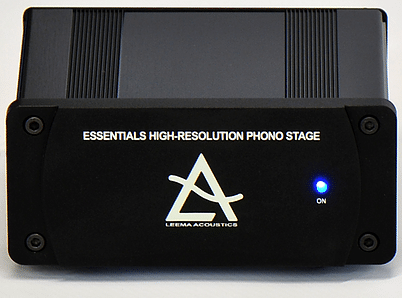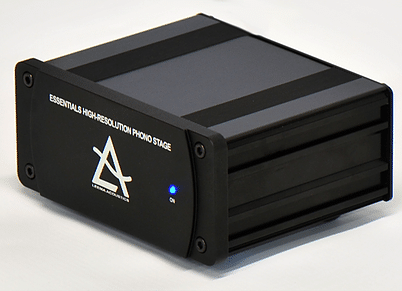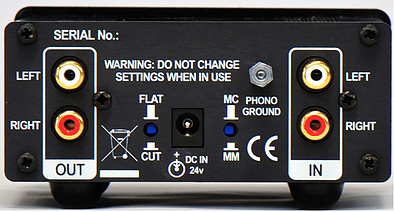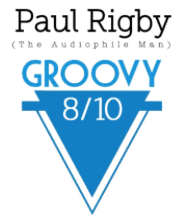The Article
Leema Essential High Resolution Phono Amplifier: A Leema Of Faith
3rd October 2015

Promising a quality phono amp for a small footprint and smaller price, Paul Rigby reviews the Leema Essential High Resolution Phono Amplifier
The phono amplifier magnifies the tiny cartridge signal from your turntable. Lifting the signal to a level that is useful for your amplifier. This part of the hi-fi chain is too often ignored but, for vinyl fans, it can make or break your entire hi-fi system. This box (or boxes if split into two) is so close to the source signal that it is important that it does not hamper it. Relying on the basic built-in bit of kit often found within an integrated amplifier is just not good enough. An external model, like this Leema example, is required to get the most from your records.
External phono amps can be expensive items while cheaper alternatives can sometimes offer less than satisfactory service. This budget model is a welcome entry into the sector, therefore. But is it any good?
The build quality of the Leema, on the face of it, is of a high standard. The sturdy chassis is built like a miniature brick. Inside, the guts of the thing is based upon the Agena Reference Series Phono stage.
The front is bare apart from a tiny ‘On’ light while the rear sports the standard phono amp inputs and outputs plus a grounding post and two switches. The Essential Phonostage is switchable for use with both moving coil and moving magnet cartridges and includes a switchable low frequency filter. The low frequency filter only operates below 20Hz to stop the by-product of warped records and turntable motor or bearing noise.
Both switches are important. The switch to choose between moving magnet and moving magnet is crucial, in fact. And we should not assume that this switch will only be accessed once and never seen again either. I know penty of hi-fi fans who bounce between MM and MC on a regular basis for one reason or another. So, why are both of these switches hidden from view? Both are situated underneath the outer chassis, accessible down a dark hole.
It would be great to remove the more mystical elements and inherent fear out of audiophile hi-fi kit, attracting the general public into the hi-fi fold but arcane design quirks like this certainly do not help.
It’s bad enough that, in this day and age, we don’t have audiophile automatic sensors that, Apple-like, do the cartridge loading and type selecting for you but when a manufacturer can’t find a way to put two, easily accessible, physical buttons on the rear of a small chassis then I throw my hands up in frustration. In the grand scheme of things, it’s pretty small beer, I know. But to say to a user that the only way you can select between moving coil and moving magnet is to tell him, right after he’s just spent £500 on the product, mind you, to then ferret around in the bottom of a lonely drawer to find a sharp pointy thing like a small screwdriver to push the hidden bloody button in is exasperating. Most audiophiles won’t be bothered by my gripe and many more will wonder why I’m rabbiting on at all but, well, it’s 2015 folks. We should be past this sort of thing by now.
Offering a moving magnet gain of 36dB and a moving coil gain of 62dB, the Leema can be criticised for not supplying more cartridge loading options.
IN USE
To properly tackle the sound tests, I selected three phono amps to test both moving magnet and moving coil. To begin, I hooked up the Cambridge Azur 540P, moving magnet stage (now succeeded by the 551P and worth around £70). I then inserted the highly rated ANT 3T Kora Special Edition which is priced at around £350 and is a better performing moving magnet phono amp. Finally, I brought in a Trichord Dino, which is similarly priced to the Leema, for moving coil comparisons.
SOUND QUALITY
I hooked up the Cambridge in MM mode and played Yes’ Starship Trooper from The Yes Album. At first glance, the use of the Cambridge would appear to be a total mismatch. The £70 Cambridge is an entry-level phono amp but the comparison is a valid one. After all, if you are an entry level user, is it really worth upgrading or is it best to stick with what you have?
After using the Cambridge, the immediate impact from the Leema was the sound of the welcome, smooth nature of the upper mids. The vocal harmonies on this track saw the Leema provide a mature, cultured and wholly civilised presentation. The basic reason for this was the reduced distortive noise over the upper frequencies due to the better quality of the basic components. Not surprising, of course, with the larger product budget but good to see that it was money well spent.
Allied with that was a reduction in upper mid bloom over the electric guitar attack. Steve Howe puts his guitar strings into pretty extreme places at times which forced the Cambridge to hit rather harsh areas of the upper mids. The Leema, on the other hand, added a more characterful and balanced tone, providing a greater tonal realism.
I wouldn’t say that the Leema added any dramatic improvements in bass but what it did do, again, was deliver lower frequencies in a more recognisable and more satisfactory manner. Drums sounded like the real thing while overall percussion was sprightly, immediate and offered new levels of texture.
Swapping the Cambridge for the ANT was a more testing comparison for the Leema. The similarly priced ANT is a top performing MM phono amp that has been well received by the critics, myself included.
Using the Yes track again, it was evident that, instead of the ANT’s quite raucous upper mids and brazen bass, the Leema was a cultured performer. Giving a slightly sweeter, less in your face, presentation, the Leema avoided the ANT’s predilection to add a well lit midrange reflection on the plucked acoustic guitar strings. Instead, the Leema added a new measure of clarity that retained the detail along with a reassuring slice of warmth. This also meant that treble had an ethereal, shimmer. Cymbal strikes were more cloud-like than the aggressive ANT.
The tone adopted by the ANT did mean that the ANT was a bit of a bass demon. Providing a thumping lower frequency performance that, within rock, provided an enjoyable forward momentum. The Leema reigned back a touch because the sweeter upper mids were not giving the bass a crystal clear etching. Instead, the bass almost had a soft, yet still weighty feel that reminded me of production techniques favoured in the studio during the 70s.
I moved to my moving coil Benz Glider next and brought in my similarly priced Trichord Dino as a comparison. Playing Holst’s The Planets and Mars – The Bringer of War, I was very impressed by the general MC performance from the Leema. Above all, the dynamic contrasts on this rather forbidding track are easy to lose from a phono amp that looks too much towards the middle ground. Not the Leema. The early part of this track is full of portent and the Leema just loved to get stuck in to deliver that very same effect.
The low tones of the the strings on the LP are packed with skidding metal string noises. The Leema really emphasised this aspect of the track, giving the music an almost industrial aspect. At this point in the track I did consider that, just possibly, the gain was too low but was reassured by the Leema’s dynamic abilities as the music built and the sheer power of the combined brass and strings surged upwards. The Leema was not only comfortable but it really dived into the fun, adding force behind the bass-tones of the strings. OK, it might not have had the grumbling lower bass of a more expensive phono amp but there was enough control and authority to slowly push my head back into my chair in expectation.
Above all, the increasingly complex music on offer from this involved arrangement was easily navigated by the clean nature of the Leema’s presentation. The low noise aspect of the unit provided the air and space that this music needed, creating a spectacular crescendo without any strain or confusion.
CONCLUSION
The Leema Essential is a capable, if sometimes slightly safe moving magnet performer that is, despite that, both sweet in nature and well balanced. It really comes alive in its moving coil mode, though. Despite the lack of loading options, the Essential is a sparkling performer. Clean, open and spacious in nature, it sets your music free. A great conclusion for a phono amp at this price.
LEEMA ESSENTIAL HIGH RESOLUTION PHONO AMPLIFIER
Price: £500
Website: www.leema-acoustics.com
Tel: 01938 559021
Good: small footprint, clean and delicate midrange, low noise, MC performance
Bad: cartridge loading options, design quirks, no mono button





